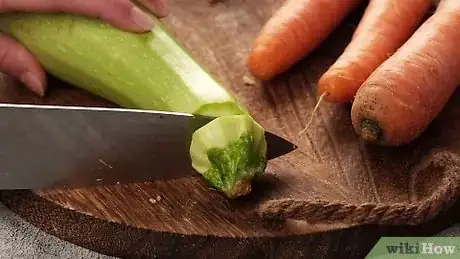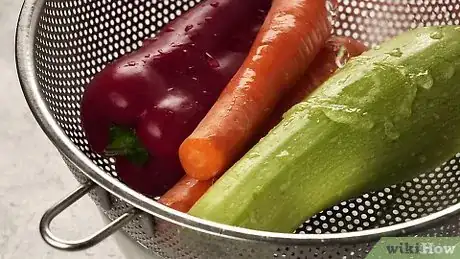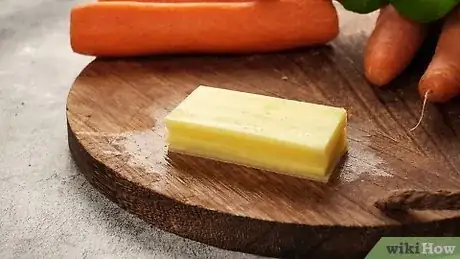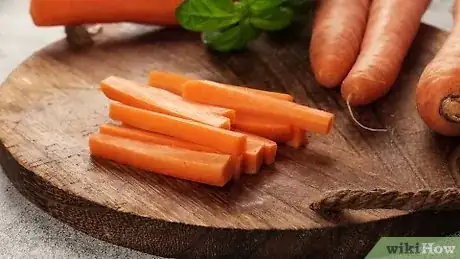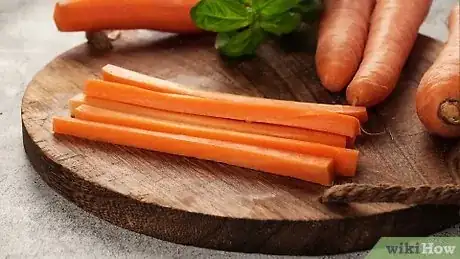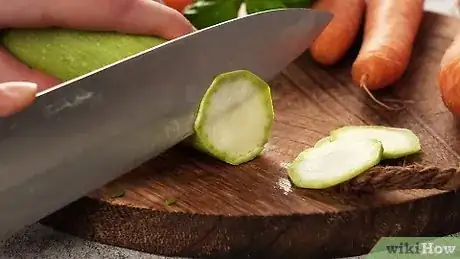This article was co-authored by wikiHow Staff. Our trained team of editors and researchers validate articles for accuracy and comprehensiveness. wikiHow's Content Management Team carefully monitors the work from our editorial staff to ensure that each article is backed by trusted research and meets our high quality standards.
The wikiHow Video Team also followed the article's instructions and verified that they work.
This article has been viewed 389,342 times.
Learn more...
A formal vegetable cut is a standard way of cutting vegetables. There are many different formal cuts, including the julienne and brunoise, and they're all used for different purposes. The main reason to learn formal vegetable cuts, however, is because they ensure your vegetable pieces are uniform in size, and this makes for an even cooking time and food that looks great. Most vegetable cuts aren't overly difficult to learn, but they do take patience and practice to master.
Steps
Preparing Vegetables for Cutting
-
1Trim tops, stems, and roots. Place your vegetables on a cutting board. With a sharp knife, carefully trim off the leaves, stems, tops, and tails. Discard these pieces, or add them to a collection of vegetable scraps for making broths.
- You can do many formal vegetable cuts with any fruit or vegetable.
-
2Wash the vegetables. Wash the vegetables under running water, and scrub hard vegetables, like potatoes and carrots, with a vegetable brush. Brush softer vegetables, like peppers and tomatoes, with a cloth or your hand.
- You don’t need to use soaps, detergents, or special cleaners to wash produce.[1]
Advertisement -
3Peel vegetables with skins if you want. Use a vegetable peeler or sharp knife to peel away the outer skin from vegetables like squash. For vegetables like carrots, potatoes, and cucumbers, the skins are edible and you can leave them on if you wish.
- Fruit and vegetable skins contain lots of nutrients, so if you aren't worried about aesthetics, leave the skins on instead of peeling them.
-
4Square off cylindrical vegetables. Slice one lengthwise side of the vegetable to make a flat and even side. Turn the vegetable onto the cut side, and repeat with the other three sides. Trim off the tapered tops and bottoms so you have a 2-inch (5-cm) long rectangular piece of vegetable to work with, which will make it easier to cut the vegetables into uniform pieces.[2] >
- Instead of throwing out the excess that you’ve cut off, consider saving it for soups, juices, or other dishes.
- Cylindrical vegetables that need to be squared include carrots, potatoes, zucchini, eggplant, and cucumbers.
-
5Cut round vegetables in half. Round vegetables like tomatoes and onions should be cut in half before slicing, because this will make it easier to hold them steady. Cut the fruit in half through the middle, rather than in half from stem to bottom.
- For tomatoes, use your finger to pick out the seeds and juice from the middle if you're making a salsa or other dish that you don’t want to be runny.[3]
Making the Basic Julienne and Brunoise Cuts
-
1Cut the vegetable into very thin slices. Place your vegetable on a cutting board so it’s laying flat on one of the squared edges. Hold the vegetable steady with one hand, and with your other hand, use a sharp knife to cut the vegetable into thin, lengthwise slices. The slices should be one-eighth-inch (3 mm) thick.
- As you cut, keep the vegetables steady with your one hand, but move your fingers back as you go to keep them out of the way of the knife.
- For fine julienne vegetables, cut the slices to a thickness of one-sixteenth-inch (1.6 mm).[4]
-
2Stack the slices. When you have cut the entire vegetable into thin slices, collect and arrange the slices like you would with a deck of cards. You want all of the slices to be neat, tidy, aligned, and facing the same direction. Lay the stack of slices flat on the cutting board.
-
3Cut the slivers into thin sticks to make the julienne cut. Hold the stack of vegetables steady with one hand, and use your other hand to cut the slices lengthwise again into long, thin sticks.[5] The thickness of the cuts should be the same as the first ones. This thin, stick-like cut is known as the julienne (sticks that are one-eighth-inch (3 mm) thick), or the fine julienne (sticks that are one-sixteenth-inch (1.6 mm) thick).
- From here, you can leave the vegetables julienned, or dice them into small cubes, which is known as the brunoise cut.
- Julienned vegetables are often used as garnish and in sauces.[6]
-
4Dice the julienned vegetables into very small cubes to make the brunoise cut. Stack the julienned vegetables so they're neat, tidy, and facing the same direction. Turn the stack to make perpendicular cuts to the sticks. Hold the stack steady with one hand, and use your other hand to cut. For the brunoise cut, dice the julienned sticks into one-eighth-inch (3-mm) cubes.[7]
- For fine brunoise, cut fine julienned sticks into one-sixteenth-inch (1.6-mm) cubes.
- Brunoise vegetables are often used as garnish and decoration.[8]
Making Small and Large Cuts
-
1Try the small stick. The batonnet is a small stick cut that’s similar to the julienne, and the only difference is the size of the sticks (batonnet is larger). Cut the squared vegetable lengthwise into quarter-inch (6-mm) thick slices. Stack the slices and lay them flat on the cutting board. Then, cut the slices lengthwise again into sticks that are a quarter-inch (6-mm) around.[9]
-
2Turn a small stick into a small dice. Just like you can turn a julienne into a brunoise, so too can you turn a batonnet into a small dice, which is called the macedoine. Stack the batonnet sticks so they're neat and tidy. Turn the sticks to make perpendicular cuts. Hold the sticks steady with one hand, and use the other hand to cut the batonnet sticks into quarter-inch (6-mm) cubes.
- The macedoine cut is often used for vegetables that will be included in cold salads.[10]
-
3Cut vegetables into large sticks. Large sticks, called the baton cut, is the same as the batonnet, except that the sticks are three-quarters of an inch (19 mm) around instead of a quarter-inch (6 mm). Slice the vegetable lengthwise into three-quarter-inch (19 mm) slices, and then slice those lengthwise again into three-quarter-inch (19 mm) sticks.
- Although the baton cut isn't a hugely common cut for vegetables, you start with the baton to achieve the carré, or large dice.
-
4Turn the large sticks into a large dice. Stack the baton sticks and turn them so you can make perpendicular cuts. Hold the sticks steady with one hand, and use your other hand to dice the sticks into three-quarter-inch (19 mm) cubes.[11]
- The large dice is also called the carré cut, and it’s used for vegetables that are added to soups, stocks, and many other dishes.
-
5Cut leafy greens and herbs into thin strips. Stack your leafy greens or herbs on top of one another, with the largest leaves at the bottom and the smallest ones on top. Roll the leaves up into a tight cylinder, like a cigar, from stem to tip. Hold the cylinder closed with one hand. Starting at the outside edge of the leaves, slice thin strips of leaves from the greens.[12]
- The type of cut is called the chiffonade, and it’s ideal for spinach, basil, and other fresh leafy vegetables that are used as garnish or decoration.
-
6Learn the paper-thin cut. This is a fun and creative cut because you can use it with any vegetable, and you can cut the vegetable into any shape you like. The pieces should be paper thin and the size of a penny. Start with a baton cut vegetable or any vegetable that’s about the diameter of a one-cent coin. Dice the vegetable into thin slices that are about 0.03 inches (1 mm) thick.
Community Q&A
-
QuestionHow do I wash fruits?
 Community AnswerJust use cold running water from your sink. You don't need to use soap - just make sure you have fully rinsed and dried the fruits.
Community AnswerJust use cold running water from your sink. You don't need to use soap - just make sure you have fully rinsed and dried the fruits. -
QuestionWhat should I do in looking for quirky vegetables?
 Community AnswerJust look at the vegetable, and if it looks fresh, that's a good start. After it passes the look test, make sure it feels firm and smells fresh. Then, just follow the steps in the article.
Community AnswerJust look at the vegetable, and if it looks fresh, that's a good start. After it passes the look test, make sure it feels firm and smells fresh. Then, just follow the steps in the article.
Warnings
- Always use a sharp knife, and cut on a flat, sturdy surface to avoid accidents.⧼thumbs_response⧽
References
- ↑ https://www.fda.gov/Food/FoodborneIllnessContaminants/BuyStoreServeSafeFood/ucm114299.htm#prep
- ↑ https://theculinarycook.com/knife-skills-different-types-of-cuts/
- ↑ https://www.youtube.com/watch?v=FWOGeQHMGeM
- ↑ https://www.youtube.com/watch?v=z9lYQF0JJ_k
- ↑ https://theculinarycook.com/knife-skills-different-types-of-cuts/
- ↑ https://le-fermier.com/2015/08/07/back-to-basics-5-formal-vegetable-cuts/
- ↑ https://theculinarycook.com/knife-skills-different-types-of-cuts/
- ↑ https://le-fermier.com/2015/08/07/back-to-basics-5-formal-vegetable-cuts/
- ↑ https://www.youtube.com/watch?v=ML5flgorZYc
- ↑ https://le-fermier.com/2015/08/07/back-to-basics-5-formal-vegetable-cuts/
- ↑ https://www.youtube.com/watch?v=z9lYQF0JJ_k
- ↑ https://theculinarycook.com/knife-skills-different-types-of-cuts/
- ↑ https://www.youtube.com/watch?v=z9lYQF0JJ_k
- ↑ https://le-fermier.com/2015/08/07/back-to-basics-5-formal-vegetable-cuts/
About This Article
To do formal vegetable cuts, start by trimming off any tops, stems, and roots on your vegetables. If you're cutting cylindrical vegetables, cut off the rounded edges to square them off, and if you're cutting round vegetables, cut them in half. Next, cut the vegetables into thin slices and then stack the slices on top of each other. Then, cut down through the stack to make thin sticks, known as the julienne cut. You can stop there, or you can stack the thin sticks and cut them into cubes to make the brunoise cut. To learn how to make small and large formal vegetable cuts, scroll down!
